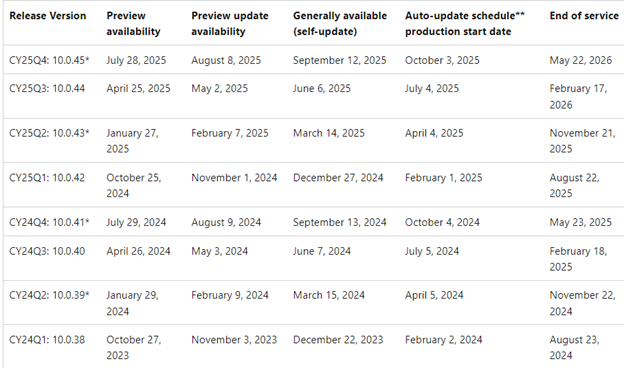In2018, Microsoft released the Continuous Update policy for Dynamics 365 Finance & Supply Chain Management (D365 FSCM), which included seven service updates per year.
Last month Microsoft announced it reducing the number of service updates released per year to four. Here’s what to expect with these upcoming D365 FSCM release schedule changes.
NEW RELEASE SCHEDULE
Major releases, previously known as the Spring and Fall updates, will shift to January and July, with minor updates in April and October. The new naming convention will also be introduced at the same time.
Major releases will be denoted on version numbers with a “*”, e.g., “CY25Q2: 10.0.43*”.
The update name will consist of two segments.
- The first will denote the year and quarter the update is scheduled to automatically be applied to production environments.
- The second segment will be the update version. For example, “CY24Q1: 10.0.38” is version 10.0.38 that will be automatically applied to production from the first quarter of 2024 onwards.
You can only pause one consecutive update instead of three.
The total minimum number of updates you are required to take per year remains at two.
The management of updates—pausing, scheduling, and deploying to sandboxes—is still through LCS, as described here: https://learn.microsoft.com/en-us/dynamics365/fin-ops-core/dev-itpro/lifecycle-services/pause-service-updates?context=%2Fdynamics365%2Fcontext%2Fcommerce
Upcoming Release Schedule

PROACTIVE QUALITY UPDATES SCHEDULE
Proactive Quality Updates (PQUs) remain unchanged and will be pushed in between service updates, delivering periodic cumulative hotfixes.
The PQUs will follow the same “safe-deployment” model, which first delivers the PQUs to a single region that contains a small group of customers who have the highest tolerance for risk.
When no regressions are identified, the process continues through a broader group of customers, based on geographies (stations), until all customers are using the new version.